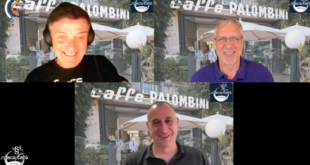by Valentin Eder

This article describes – in a non-diplomatic way – the current setting/behaviour of space industry stakeholders and a set of radical, but necessary actions to ensure the long-term sustainability of outer space in the interest of operators, the industry, last but not least, of the global society. This article follows “How Mega-Constellations Lead to Increased Sustainability Risks in Outer Space” published on 7 February 2021 on SpaceWatch.Global.
The given results: Is it Safe in Space?
The results from our previous article ‘How Mega Constellations Lead to Increased Sustainability Risks‘ show a more than drastic picture regarding the current risk level in outer space.
By the end of 2020, there were around 540 conjunctions < 1km per day for parts bigger than 10cm in Low-Earth Orbit (LEO) and the number keeps increasing with a monthly rate of around 2%. This results in a mean interval between conjunctions of less than 3 minutes. If these 3 minutes are scaled up for parts bigger than 1cm (factor ~38), there is a conjunction < 1km every 4.5 seconds. This is more dramatic than estimated so far.
Risk and Freedom
Once a risk is identified, one can usually start with suitable mitigation measures. However, as of today, collision risk mitigation is handled in a self-centred approach. Each satellite operator takes care of their own infrastructure in space, and only of that. In this operating mode, none of the operators, whether military, governmental, scientific or, commercial, has any interest to look at the overall situation and, consequently, none of them is willing to invest time and resources on such wider perspective. The analysis of the overall situation and corresponding measures are left to the ‘others’, namely to regulatory bodies, space agencies, and science organisations. The ‘space resource’ does not belong to anyone (i.e. we have a typical Tragedy of the commons).
But in the case of a defragmentation, little can be done on technical level, especially as space debris removal is still in its infancy. Effective regulations would therefore be needed, but as of today we only have non-binding and insufficient guidelines which many operators do not duly observe. The lack of any obligations leaves the operators with the freedom to do nothing. The goal of a mission is a successful operational phase, and often enough no attention is paid to its controlled and safe disposal. There are no benefits for operators to bring down objects safely and no consequences of just leaving them where they are. According to the latest ESA environment report, most of the debris results still from ‘natural’ defragmentation and not from collisions. Until now. The problem is significantly increasing with the “NewSpace” developments, as a remarkably increasing number of companies are putting objects in space with lower standards in safety, just to keep costs down and to enjoy a fast market entry.
Internal Working Groups and Conflict of Interests
The operators organise themselves in different organisations and working groups such as SDA or SSC and they exchange space object and manoeuvre data on a peer-to-peer basis. These initiatives, coupled with the IADC rules, the relevant ISO standards and the SSC Best Practices, are in the interest of the active space players. This is very welcome per se and there is nothing wrong with it. However, a fundamental problem persists.
The space sector is a collection of scientific organisations, commercial companies and governmental/military stakeholders, with very different interests. All of them are interested in decreasing risks in space, but none of them is willing to sacrifice own interests and activities for that. Therefore, the discussions in the different fora circle around technology solutions to fix the problem. The majority of our society and of its policy makers do not have the understanding of what is the risk in space and what are the possible consequences. In addition, the national and international policy makers are not free from industrial influence and of course they will consider aspects such as national competitiveness or strategic dominance. With “NewSpace”, the companies’ interest in growth of revenues and stock prices increasingly prevails over their own interest to act according a sustainable space environment. The space community is widely driven by stock exchange value and political interests. For the author, this is a strong analogy to the interests involved regarding the safety of nuclear power and solutions for nuclear waste management.
To mention three examples:
- An STM study within the EU Horizon 2020 started in January 2021.
The study seems to be driven by industry (52% of the EU Funding) with participation of science organisations (34%), tied to the industrial storyline. It is to be seriously questioned what companies producing satellites and rockets and providing space services can contribute towards an effective space traffic management. The role of these companies in the STM study could be – in the best case – as external stakeholders. There is a big risk that the study generates results and recommendations which are in line with the lobbying strategies of the major-companies. To give an analogy: Should airlines, hotels, bars, shops, fitness centres lead the task force to define the rules for handling the Covid pandemic?
- A second EU STM study is led by GMV. Which generates within GMV a clear conflict of interest, as they push their ownSTM commercial Also this study is dominated by commercial actors with a 51% share, followed by research organisations with a 12% share and with a marginal participation of lawyers (2%). Participation of operators is only at 8%.
- A third example is the actual tender on EUSPA/GSA where the the award criteria is 40% of price, 39% of methodology and approach but only 6% to handle the conflict of interests.
To make one thing clear: The individuals involved in these studies are of high professionalism and integrity, with very valuable knowledge, and working for the big players in the ‘space industries’. There is nothing wrong about that and they are most honourable people. Nevertheless, the company interests are in a logical contradiction to a sustainable space resource management.
What about Consequences and the Conflict of Interest?
The meta-goal has to be: compliance to the long term sustainability guidelines (LTS). The LTS needs to gain relevance for the the operator/owner’s business-case. If mission operations do not follow the LTS, the operator should risk facing consequences. If an entity inserts an object in outer space, such entity should be hold responsible until the object has de-orbited completely. On the other hand, operators who comply to LTS should have a benefit, maybe financed by the ‘non-compliant’ ones.
Suitable ways to implement the polluter-pays-principle are existing and it depends just on the political willingness (and before that: awareness) to implement respective obligations on national level (LTS A.1 and A.2).
A key aspect in LTS is transparency (B.1, B.2, B.3) which means that all operators must ensure the publishing of:
- object data (size, material, capabilities of propulsion,…) according to LTS B1 to ensure LTS 5
- change of object state (e.g. loss of propulsion) according to LTS B1 to ensure LTS 5
- daily measurement of their objects including publishing of position (to ensure LTS 4) and emissions (e.g. RF)
This transparency enables
- orientation (navigation) input for other operators on a traceable and accountable basis
- assessment of data quality
- traceability of operations behaviour for regulators (LTS 3 and A.4), service providers, suppliers and the public.
- Input to science for a better understanding of the effects (LTS 1)
LTS compliance is not (yet?) in the interest of object operators, they are lobbying that measures (e.g object measurements) should be financed by public money. LTS compliant behaviour (including the necessary monitoring) costs money in operations. Therefore, it would need a balancing between some benefit for compliant behaviour on the one hand and a risk of consequences for non-compliance on the other hand.
Proposal for implementation of a sustainable space environment in accordance with the LTS
Lock-down of all launches (except ISS-related) until the following conditions are fulfilled:
- Transparency of space objects
Entry into the UNOOSA registry of all objects before launch with all necessary details and with the duty to notify updates of any changes. - Strengthening National space laws
- (a) National implementation of space laws with LTS as guidance and strict compliance obligations on operators under respective authorisations.
- (b) Ban of companies who are not complying to LTS from public contracts and grants (also in the role of sub-supplier to a mission not LTS compliant).
- (c) LTS Compliance for operators as self declaration to enable and strength liability also on the civil law level.
- (d) Responsibility for the management of non-operational space objects (without fuel and completely dead space objects) under there responsibility of the owner (and behind the owner: the registration state)
- (e) Introduction of a space resource utilization fee to finance the monitoring of LTS compliance (e.g. €1 / orbit cycle per object)
- (f) Build up LTS monitoring facilities (analogy to terrestrial RF monitoring) to enable execution of national laws and license conditions
- (g) Rules of public notice by operators of any irregularity in space operations (space craft failures, close conjunctions, critical events, loss of ..) →analogy to nuclear radiation events
- (h) Rules of mandatory regular publishing actual space craft location, manoeuvres and emissions (e.g. RF) by operators
- (i) Rules that all (new) rocket bodies have to re-entered within max 2 days after launch
- (j) Rules to publish the space-operation concepts of the operators, especially for (mega) constellations
- (k) Rules for emergency situations, including mandatory emergency plans with clear escalation paths
- (l) Obligation of orbit evacuation plans (exit the orbits in case of collision), exit paths (in case of evacuation how and whereto bring the satellites in safe situations)
- Resolve conflicts of interests
- (a) Rules to avoid and to handle conflicts-of-interest of stakeholders (liability of transparency) →should apply g. for SDA, ESA,EUSST, EU, EUSPA/GSA contracts and operations.
- (b) Involve other disciplines into the STM/SEM topic (e.g. https://gmv.gu.se/, https://www.csh.ac.at/) to utilise know-how from other science fields also in space management.
- Finance space debris removal
Introduce a space removal fund financed by the operators/owners to remove space debris parts as rocket bodies, satellites and other objects (e.g. Envisat or dead GEO objects) - International ban of any anti satellite attacks
International ban of any anti satellite attacks (like Fengyun 1C) applicable to all types of space objects.
The proposed actions would apply to all space actors so that the negative impacts would be equalised.
Conclusion:
Compliance with LTS should become mandatory for all operators in all countries. An effective monitoring systems should be implemented in analogy the RF or nuclear radiation monitoring.
Challenges
What are the challenges to effectively implement the LTS guidelines on national level:
- Awareness: to bring the topic to the understanding to the national decision makers. A systemic risk (collision and RFinterference) risk presentation and monitoring and analyses would help to raise such awareness
- Transparency: to bring all operators to a ‘Measure, Publish, Inform, Act’ behaviour.
- Bring the law makers to an understanding how to formulate the 21 LTS guidelines into obligations under national space law.
- National implementation of LTS ‘audits’ to have ‘evidence’ of non-compliance (analogy to RF measurements by national telecommunications regulatory authorities).
- To show the stakeholders the impacts and consequences of continuing no action and also the benefit of the proposed actions.
- Formulate best practices how to operate space objects (in all mission phases). Such best practices would also help to identify and prove deviations of compliant behaviour.
Space Analyses (Vienna, Austria), founded in 2014 by Valentin Eder, digs into the convergence of Big Data with the Space-Time Continuum and applies the results to domains such as Satellite Communication and Space Debris Management. Space Analyses develops holistic data analytics solutions for Satellite Payload and Spacecraft Operations. With its comparably unique combination of Earth Observation, RF monitoring, Satellite Operations and SW Development know-how Space Analyses is a valued partner of Satellite and Satellite Network Operators.





